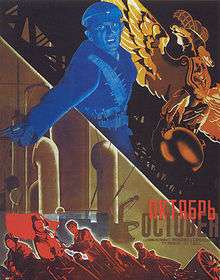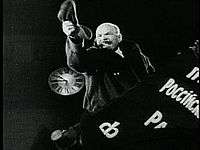October: Ten Days That Shook the World
| October: Ten Days That Shook the World | |
|---|---|
 Film poster | |
| Directed by |
Grigori Aleksandrov Sergei Eisenstein |
| Written by |
Grigori Aleksandrov Sergei Eisenstein |
| Starring |
Vladimir Popov Vasili Nikandrov Layaschenko |
| Music by | Dimitri Shostakovich |
| Cinematography |
Vladimir Nilsen Vladimir Popov Eduard Tisse |
| Distributed by |
Sovkino (USSR) Amkino Corporation (US) First National Pictures (through)[1] |
Release dates |
|
Running time | 104 minutes |
| Country | Soviet Union |
| Language |
Silent film Russian (original intertitles) |
.webm.jpg)
October: Ten Days That Shook the World (Russian: Октябрь (Десять дней, которые потрясли мир); translit. Oktyabr': Desyat' dney kotorye potryasli mir) is a 1928 Soviet silent historical film by Sergei Eisenstein and Grigori Aleksandrov. It is a celebratory dramatization of the 1917 October Revolution commissioned for the tenth anniversary of the event. Originally released as October in the Soviet Union, the film was re-edited and released internationally as Ten Days That Shook The World, after John Reed's popular book on the Revolution.[2] In U.S. released by Amkino Corporation and First National (later was a subsidiary of Warner Bros.).
Plot
The film opens with the elation after the February Revolution and the establishment of the Provisional Government, depicting the throwing down of the Tsar's monument. It moves quickly to point out it's the "Same old story" of war and hunger under the new Provisional Government, however. The buildup to the October Revolution is dramatized with intertitles marking the dates of events.
April 1917 Vladimir Lenin returns to a railroad station packed with supporters.
July 1917 The demonstrations in Nevsky Square are fired upon by the army. The government orders the working class to be cut off from the city center, and in a dramatic sequence the bridges are raised with the bodies of the Bolsheviks still on them as the Bourgeoisie throw copies of the Bolshevik newspaper into the river.
The Bolshevik headquarters also is destroyed by the ruling class, and the Provisional Government orders the arrest of Lenin, who has gone underground but continues to direct the plans for the uprising. Provisional Government leader Alexander Kerensky is mockingly characterized and compared to a mechanical peacock and Napoleon, before satirically being accused of aspiring to the Russian throne.
General Kornilov advances his troops on Petrograd. While the government is helpless the Bolsheviks rally to the defense "for God and country." The Bolsheviks take control of the city's arsenal and General Kornilov is arrested. Leaflets spread the messages of the revolution, and workers are trained to use weapons for the "last and decisive battle."
October 1917 The Bolshevik Committee votes to approve Lenin's proposal to revolt.
October 24 Lenin returns to the Smolny after four months in hiding and takes control of the uprising on the eve of the 25th. A message is sent to the people declaring the Provisional Government is deposed as of October 25 at 10 AM.
October 25 The cruiser Aurora sails in as the workers take control of the bridges. The Minister of War calls troops to the aid of the deposed government, and Cossacks and the Women's Death Battalion arrive at the Winter Palace and lounge on the Tsar's billiard table. The Provisional Government drafts an appeal to the citizens attempting to reassert its legitimacy, but that evening a congress is held including delegates from all parts of the country and the Soviets are voted into power.
With the weapons and preparations by the Military Revolutionary Committee, Bolsheviks march immediately on the Winter Palace and demand its surrender. The Provisional Government, seemingly aloof, gives no reply. The Women's Death Battalion surrenders and kills their superiors. A group of Soviets infiltrate the vast palace through the cellars and locate the government forces inside. The Cossacks surrender and join the Soviets. At the congress, the Mensheviks appeal for a bloodless end to the conflict falls on deaf ears.
The signal is given by a shot from the Aurora and the assault begins in earnest. In an epic climactic sequence, Soviets storm the palace en masse and overwhelm the defending forces. Soldiers in the palace raid the palace for valuables, only to have their pockets turned out by the Soviets once they have surrendered. Finally, the Soviets beat down the door to the Provisional Government's chambers and arrest the government members. Vladimir Antonov-Ovseyenko drafts a formal statement declaring the Provisional Government deposed. Clocks around the world are shown marking the time of the revolution's success as the Soviets cheer.
October 26 The new government sets about building a new state, passing decrees for peace and land.
Cast
- Vladimir Popov — Aleksandr Kerensky
- Vasili Nikandrov — Vladimir Lenin
- Lyaschenko — Konovalov
- Chibisov — Matvey Skobelev
- Boris Livanov — Mikhail Tereshchenko
- Mikhalev — Nikolai Kishkin
- Nikolai Podvoisky — Bolshevik
- Smelsky — Dmitry Verderevsky
- Eduard Tisse — German Soldier
- Yuri Sazonov — Munist
Production
October was one of two films commissioned by the Soviet government to honour the tenth anniversary of the October Revolution (the other was Vsevolod Pudovkin's The End of St. Petersburg). Eisenstein was chosen to head the project due to the international success he had achieved with The Battleship Potemkin in 1925. Nikolai Podvoisky, one of the troika who led the storming of the Winter Palace, was responsible for the commission. The scene of the storming was based more on The Storming of the Winter Palace from 1920, a re-enactment involving Vladimir Lenin and thousands of Red Guards, witnessed by 100,000 spectators, than the original occasion, which was far less photogenic. This scene is notable because it became the legitimate, historical depiction of the storming of the Winter Palace owing to the lack of print or film documenting the actual event, which led historians and filmmakers to use Eisenstein's recreation. This illustrates October's success as a propaganda film.[3]
Style
Eisenstein used the film to further develop his theories of film structure, using a concept he described as "intellectual montage", the editing together of shots of apparently unconnected objects in order to create and encourage intellectual comparisons between them. One of the film's most celebrated examples of this technique is a baroque image of Jesus that is compared, through a series of shots, to Hindu deities, the Buddha, Aztec gods, and finally a primitive idol in order to suggest the sameness of all religions; the idol is then compared with military regalia to suggest the linking of patriotism and religious fervour by the state. In another sequence Alexander Kerensky, head of the pre-Bolshevik revolutionary Provisional Government, is compared to a preening mechanical peacock.[4]
Soundtrack
In 1966, Dimitri Shostakovich wrote a new soundtrack for the film, which later appeared as a tone poem 'October' Op.131 where Shostakovich's famous 'Partisan' theme makes an appearance.[5] This soundtrack is the one used on most DVD releases of the film.
Responses

The film was not as successful or influential in the Soviet Union as Battleship Potemkin. Eisenstein's montage experiments met with official disapproval; the authorities complained that October was unintelligible to the masses, and Eisenstein was attacked—for neither the first time nor the last—for excessive "formalism". He was also required to re-edit the work to expurgate references to Leon Trotsky, who had recently been purged by Joseph Stalin.
In spite of the film's lack of popular acceptance, film historians consider it to be an immensely rich experience—a sweeping historical epic of vast scale, and a powerful testament to Eisenstein's creativity and artistry. Vsevolod Pudovkin, after viewing the film, remarked, "How I should like to make such a powerful failure."[6]
See also
References
- ↑ Logo of First National on the lower in the left corner
- ↑ Taylor, Richard. Film Propaganda: Soviet Russia and Nazi Germany. London: I.B.Tauris, 1998. p. 63.
- ↑ Taylor, Richard. Film Propaganda: Soviet Russia and Nazi Germany. London: Croom Helm Ltd., 1979. pp. 93–94.
- ↑ LaValley, Al, ed. Eisenstein at 100: A Reconsideration. New Brunswick: Rutgers University Press, 2001. pp. 176-7.
- ↑ Bolshevik Festivals, 1917–1920, accessed 7 December 2008
- ↑ Taylor, Richard. Film Propaganda: Soviet Russia and Nazi Germany. London: Croom Helm Ltd., 1979. p. 101
External links
- October: Ten Days That Shook the World at the Internet Movie Database
- October: Ten Days That Shook the World on MosFilm video channel with optional English subtitles
- October: Ten Days That Shook the World is available for free download at the Internet Archive
- October: Ten Days That Shook the World at AllMovie